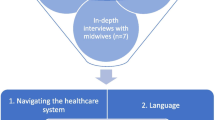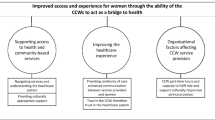Abstract
Background Health care post-birth may include referrals for additional care. Migrant (i.e., refugee, asylum-seeker, and immigrant) women frequently do not follow-up referrals for care and could be at increased health risk as a consequence. We sought to explore the inhibitors and facilitators of migrant women for following through with referrals for care. Methods Twenty-five women living in Montreal who had received a referral completed semi-structured interviews. Results Inhibitors included language barriers, transportation problems, scheduling appointments, absence of husband, absence of childcare, cold weather, perceived inappropriate referrals, and cultural practice differences. Facilitators included choice of follow-up facilitator, appropriate services, empathetic professionals, and early receipt of information. Discussion Results indicate that migrant women may not be receiving the care they and their newborns need once a concern is identified. This suggests conceiving of a different approach to the care of this population post-birth, which could include partnering with social or religious networks.
Similar content being viewed by others
Reference List
Spitzer DL. “They don’t listen to your body”: minority women, nurses and childbirth under health reform. In: Gustafson DL, editor. Care and consequences: the impact of health care reform. Halifax: Fernwood Press; 2005. p. 85–106.
Palti H. Use of control groups in evaluating the effectiveness of community health programs in primary care. Isr J Med Sci. 1983;19:756–9.
Cerkovnij G, Murnagham JH, Schmincke W, Sokolov D. The organizational or hierarchial approach. In: Measurements of levels of health. Copenhagen: Denmark; 1979. p. 93–103.
Citizenship and Immigration Canada. Facts and Figs 2007—immigration overview: permanent and temporary residents. Citizenship and immigration, Canada. 2009. http://www.cic.gc.ca/english/resources/statistics/facts2007/permanent/01.asp.
Canadian council for refugees. Immigration to Canada 1979–2001. 2001. http://www.ccrweb.ca/eng/issues/library.htm.
Citizenship and Immigration Canada. Facts and Figs 1999 statistical overview of the temporary resident and refugee claimant population. Ottawa: Minister of Public Works and Government Services Canada; 2000.
Citizenship and Immigration Canada. Facts and Figs 2004: immigration overview, permanent and temporary residents. Ottawa: Minister of Public Works and Government Services Canada; 2005.
Citizenship and Immigration Canada. Facts and Figs 2000:statistical overview of the temporary resident and refugee claimant population. Ottawa: Minister of Public Works and Government Services Canada; 2001.
Citizenship and Immigration Canada. Facts and Figs 2001: statistical overview of the temporary resident and refugee claimant population. Ottawa: Minister of Public Works and Government Services Canada; 2002.
Romanow RJ. Shape the future of health care. Canada: Commission on the future of health care in Canada; 2002. Report No.3PC2-76-2002E: Interim Report.
United Nations. Convention relating to the status of refugees of 28 July 1951. Geneva: United Nations; 1951.
Kobayashi A, Moore E, Rosenberg M. Healthy immigrant children: a demographic and geographic analysis. Report no.: W-98-20E. 1998.
Leduc N, Proulx M. Patterns of health services utilization by recent immigrants. J Immigr Health. 2004;6:15–27. January.
Harney N. Report on key informant interviews. The multicultural history society of Ontario. Study on parenting issues of newcomer families in Ontario. 2003.
Dunlop S, Coyte PC, McIsaac W. Socio-economic status and the utilisation of physicians’ services: results from the Canadian national population health survey. Soc Sci Med. 2000;51:123–33.
Hyman I. Immigration and Health. Minister of public works and government services Canada. Health policy working paper series. 2001.
Saunder NR, Tennis O, Jacobson S, Gans M, Dick PT. Parents’ responses to symptoms of respiratory tact infection in their children. Can Med Assoc J. 2000;168:25–30.
Esses VM, Dovidio JF, Jackson LM, Armstrong TL. The immigration dilemma: the role of perceived group competition, ethnic prejudice, and national identity. J Soc Issues. 2001;57:389–412.
Anisef P, Kilbride KM, Ochocka J, Janzen R. Study on parenting issues of newcomer families in Ontario. Introduction to final reports. Centre for research & education in human services (CREHS) and joint centre of excellence for research on immigration and settlement (CERIS). 30 Apr 2001.
Tyyska V, Colavecchia S. Report on individual parent interviews in Toronto. Toronto: Ryerson Polytechnic University; 2001.
Bischoff A, Bovier PA, Isah R, Francoise G, Ariel E, Louis L. Language barriers between nurses and asylum seekers: their impact on symptom reporting and referral. Soc Sci Med. 2003;57:503–12.
Andrulis D, Goodman N, Pryor C. What a difference an interpreter can make: health care experiences of uninsured with limited English language proficiency. Boston: The Access Project; 2002.
Statistics Canada. Longitudinal survey of immigrants to Canada (LSIC). 23 Feb 2009. http://www.statcan.gc.ca/pub/89-611-x/index-eng.htm.
Bowen S. Language barriers in access to health care. Ottawa, Ontario: Health Canada; 2001.
Edwards NC, Boivin JF. Ethnocultural predictors of postpartum infant-care behaviours among immigrants in Canada. Ethn Health. 1997;2:163–76.
Koyabashi A, Moore E, Rosenberg M. Healthy immigrant children: a demographic and geographic analysis. Human resources development Canada. Report no.: W-98-20E. 1998.
Truman CD, Reutter L. Care-giving and care-seeking behaviours of parents who take their children to an emergency department for non-urgent care. C J Public Health. 2002;93:41–6.
Saidullah A. The two faces of Canada: a community report on racism. Ottawa: National Anti-Racism Council; 2001.
Auslander WF, Thompson SJ, Dreitzer D, Santiago JV. Mothers’ satisfaction with medical care: perceptions of racism, family stress, and medical outcomes in children with diabetes—presented at the annual meeting of the American diabetes association, June 1995, Atlanta. Health and Social Work. 1997;22:190–9.
Reitmanova S, Gustafson DL. “They can't understand it”: maternity health and care needs of St. John's immigrant muslim women. Matern Child Health J. 2008;12:101–11.
Gagnon AJ, Dougherty G, Platt R, Wahoush O, George A, Stanger E, et al. Refugee and refugee claimant women and infants post-birth: migration histories as a predictor of Canadian health system response to needs. Can J Pub Health. 2007;98:287–91.
Liu R, So L, Quan H. Chinese and white Canadian satisfaction and compliance with physicians. BMC Fam Pract. 2007;8:11.
Cho A, Chaudhry A, Minsky-Primus L, Tso A, Perez-Perez G, Diehl DL, et al. Follow-up care after a diagnosis of helicobacter pylori infection in an Asian immigrant cohort. J Clin Gastroenterol. 2006;40:29–32.
Blackford J, Street A, Blackford J, Street A. Cultural conflict: the impact of western feminism(s) on nurses caring for women of non-English speaking background. J Clin Nurs. 2002;11:664–71.
Fox RC. Cultural competence and the culture of medicine. N Engl J Med. 2005;353:1316–9. September 29.
Kirmayer LJ, Groleau D, Guzder J, Blake C, Jarvis E. Cultural consultation: a model of mental health service for multicultural societies. Can J Psychiatry. 2003;48:145–53.
Lock MM, Kaufert PA. Pragmatic women and body politics. Oxford: Cambridge University Press; 1998.
Robinson M, Gilmartin J. Barriers to communication between health practitioners and service users who are not fluent in English. Nurs Educ Today. 2002;22:457–65.
Bischoff A, Bovier PA, Isah R, Francoise G, Ariel E, Louis L. Language barriers between nurses and asylum seekers: their impact on symptom reporting and referral. Soc Sci Med. 2003;57:503–12.
RNAO. Supporting and strengthening families through expected and unexpected life events—march 2006. Toronto: Registered Nurses Association of Ontario; 2006.
Srivastava R. The healthcare professional’s guide to clinical cultural competence. Toronto: Mosby Elsevier; 2007.
Small R, Yelland J, Lumley J, Brown S, Liamputtong P. Immigrant women’s views about care during labor and birth: an Australian study of Vietnamese, Turkish, and Filipino women. Birth: Issues in Perinatal Care & Education. 2002;29:266–77.
Nova Scotia Department of Health. Healthy babies, healthy families: postpartum & postnatal guidelines. Canada: Communications Nova Scotia; 2003.
RNAO. Interventions for postpartum depression. Report no.: 0-920166-66-0. Toronto: Registered Nurses Association of Ontario, 2005.
RNAO. Embracing cultural diversity in health care: developing cultural competence. Toronto: Registered Nurses Association of Ontario; 2007.
Acknowledgments
This study was funded by the Canadian Institutes of: Health Services and Policy Research, Gender and Health Research, Human Development, Child and Youth Health, and Population and Public Health (CIHR #123033), le Réseau de recherche en santé des populations, and Immigration et métropoles (Center of Excellence in Immigration Studies—Montreal). Le fonds de la recherche en santé du Québec (FRSQ) provided career support to AJG. Institut national de la santé et de la recherche medicale (INSERM) provided visiting scientist support to AJG during the writing of this manuscript. We received in-kind contributions from the Montreal Regional Health Board interpreter services. We acknowledge the assistance of Lisa Merry for operational support of the project and the other co-investigators on the project leading to this follow-up study (Geoffrey Dougherty, Robert W. Platt, Olive Wahoush, Anne George, Elizabeth Stanger, and Donna E. Stewart).
Author information
Authors and Affiliations
Corresponding author
Rights and permissions
About this article
Cite this article
Gagnon, A.J., Carnevale, F.A., Saucier, J.F. et al. Do Referrals Work? Responses of Childbearing Newcomers to Referrals for Care. J Immigrant Minority Health 12, 559–568 (2010). https://doi.org/10.1007/s10903-009-9242-y
Received:
Accepted:
Published:
Issue Date:
DOI: https://doi.org/10.1007/s10903-009-9242-y




